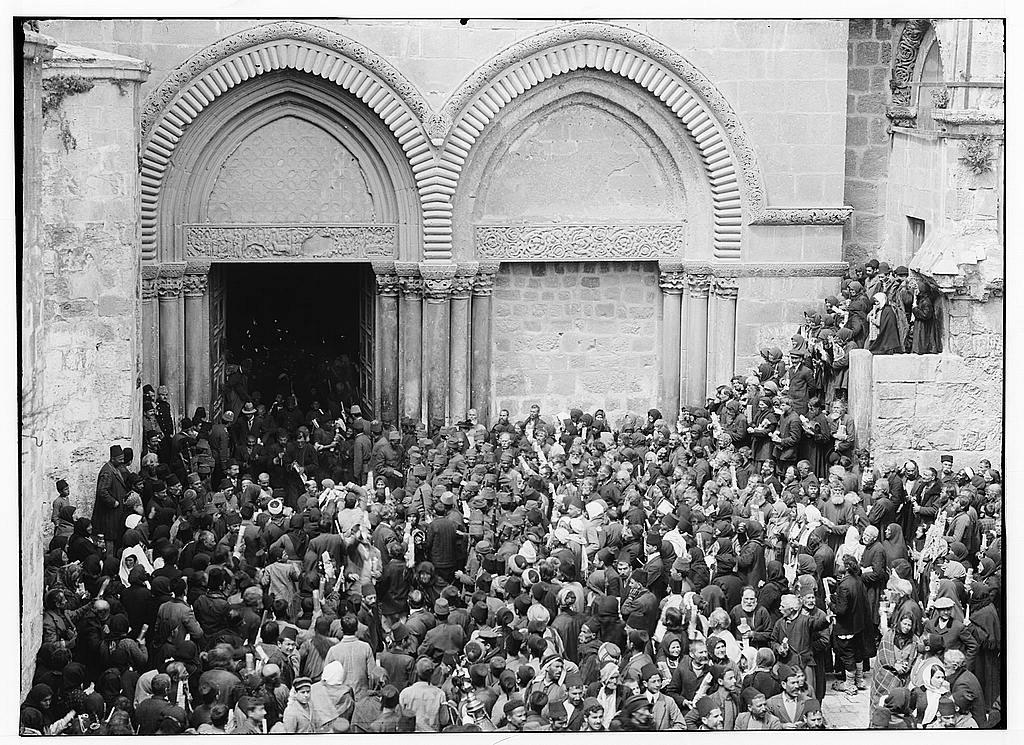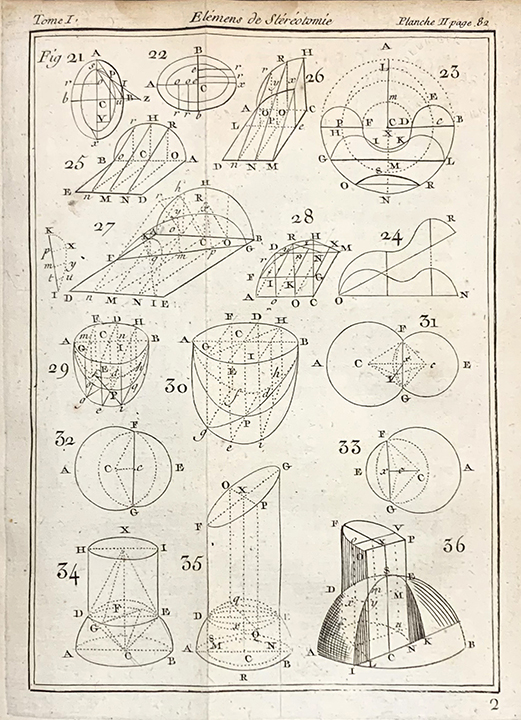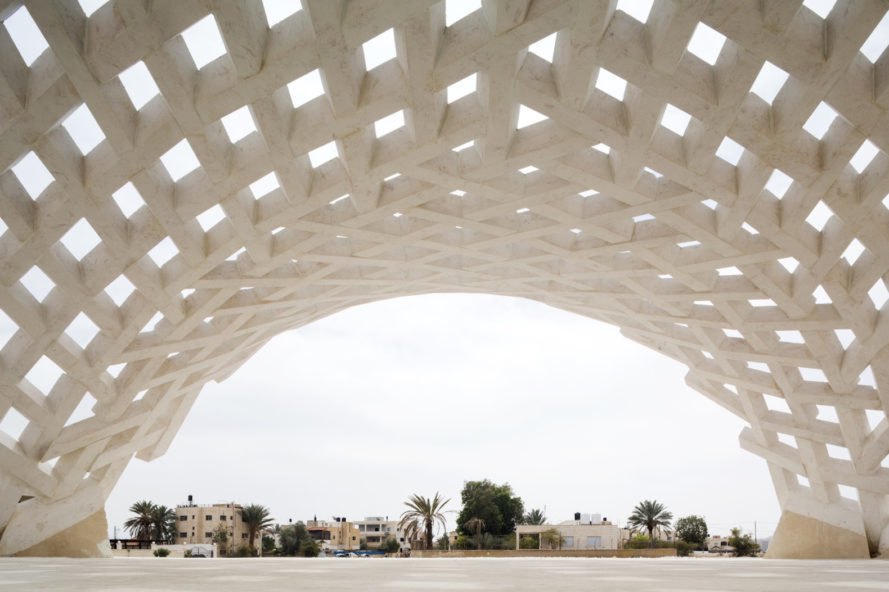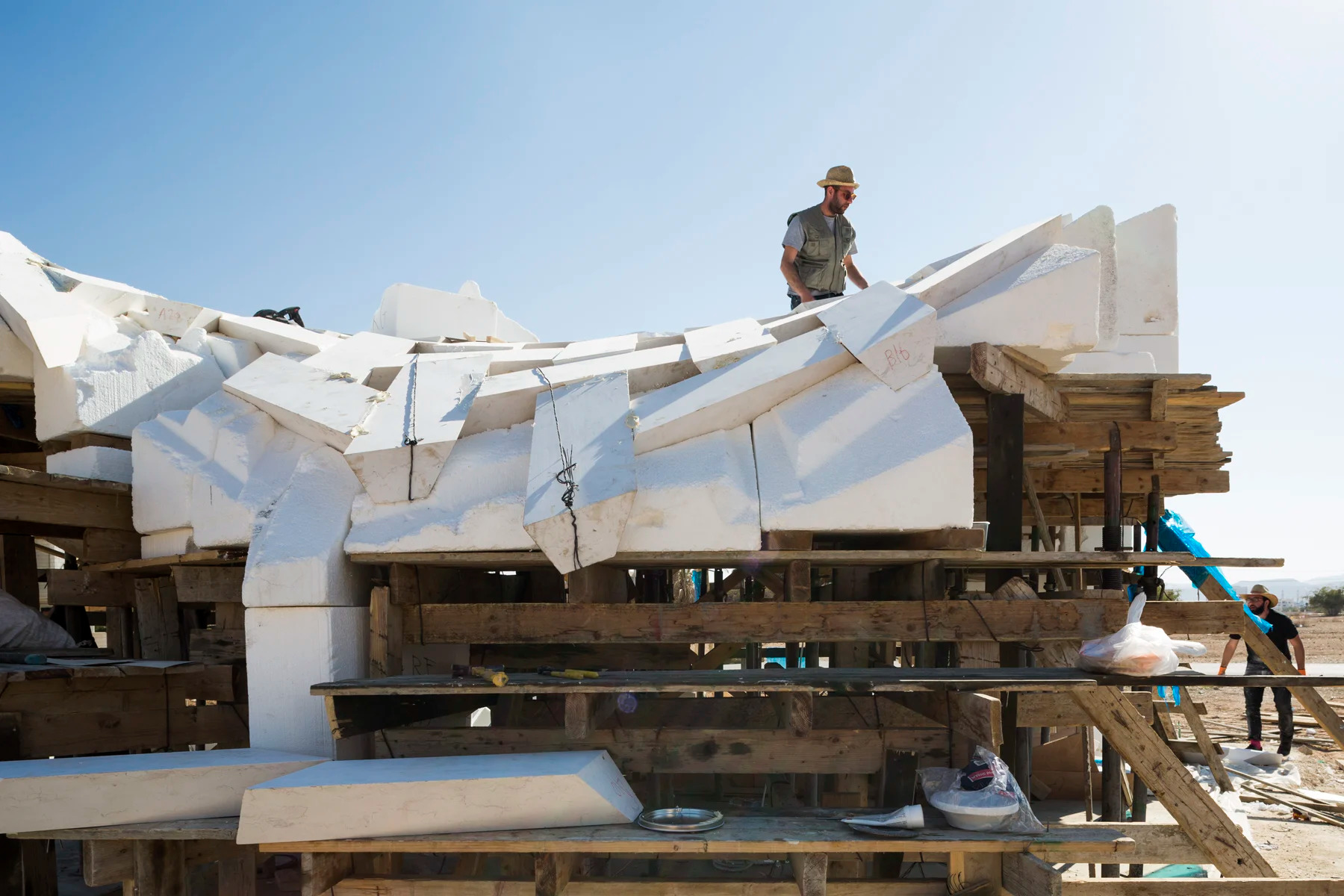Among the most extensively written about stones in Jerusalem are two lintels that used to span the Southern entrance of the church of the Holy Sepulchre. Removed in the 1930s in the aftermath of the 1927 Jericho earthquake that heavily shook Mandatory Palestine and Transjordan in the five seconds during which it lasted, the entrance currently displays the hooks that once mounted the lintels in place.1 The seismic event occurred almost a decade after the British mandate over Palestine came into force and the first of its several master plans for Jerusalem was conceived—stipulating, among other things, the use of dolomitic limestone in the cladding of facades within city limits.2
What has brought the Holy Sepulchre stones under much scrutiny is that the sequence of events depicted on the eastern lintel, which displays scenes from the life of Christ—the raising of Lazarus, Christ met by Mary and Martha, the preparations for the Last Supper, the entry into Jerusalem, the Last Supper—does not follow the accounts given in the New Testament. Art historian Alan Borg offers a rather simple hypothesis for why this might have been the case. Having looked at the lintels exclusively through photographs, Borg observes that the scene of the raising of Lazarus is depicted indoors—an unusual choice given this miracle’s common representation in Byzantine iconography. This, he suggests, could have been an attempt by the stonemason to establish symmetry with the Last Supper scene at the other end of the sequence, the only other scene commonly depicted indoors. If this was the case, the order in which the stonemason worked would have been the opposite of that of the sequence of events—leading Borg to another deduction. The unusual arrangement of the scenes “would be explicable in terms of a simple mistake. I suspect that an elaborate iconographical explanation would be inappropriate here, and that the sculptor just forgot he was working backwards.”3

Regardless of how convincing Borg’s hypothesis is, it holds a certain allure in how material considerations map on to the depiction of time and the weight given to the stonemason’s method of work (over compositional tradition) in making sense of the result. Paradoxically, the neatness of Borg’s assumption is precisely what makes it suspect. Historians’ attempts to relate the lintel’s sequence of events with the New Testament’s included proposals that the panel should be read from the center outward, with the scenes on the right side attesting to Christ’s human nature, and those to the left devoted to the divine. However, sensing the inadequacy of an iconographical explanation, Borg tells us—though tentatively—that the stonemason simply got distracted.
The debate around the Holy Sepulchre stonework is symptomatic of increasingly common tendencies among historians (and some architects, though in other ways that will be expanded on shortly) to pay more attention to process, labor, techniques, methods, know-how, and materiality, leading to results at times complementary to, and at times in conflict with, the intentionality behind the objects in question. The fact that the stonework in this case is itself depicting a narrative, the reading of which would be fundamentally altered by the agents one chooses to prioritize, makes it a case in point.
Stonemasonry techniques and working methods in Jerusalem have been central to the work of Elias and Yousef Anastas, an architect and engineer duo based in Bethlehem in Palestine. For nearly five years now, the Anastases have been researching and experimenting with stonecutting techniques—more specifically, stereotomy—as a major part of their practice. Their long-term research project Stonematters is concerned with “the re-occurrence of stone-made forms and spatial configurations in Palestine through time,” which has materialized in different projects like Analogy, which looks into stone structures around Jerusalem and explores “what interface cuts and morphology allows different kinds of spans.”4 Their research and experiments have taken different forms, including small-scale building extensions, building prototypes, and museum installations. In addition to the visceral immediacy of their structures, which defamiliarize what stone can be made to do, their work carefully circumvents common tropes associated with craftsmanship, know-how, and the possibilities architecture can hold for political traction, especially in the context of contemporary Palestine.
In his discussion of contemporary architectural practices in Egypt, particularly following the 2011 revolution, architect and writer Adham Selim argues that a by-product of the surge in alternative architectural practices that seek a more active and critical engagement for architecture with political action has been a dismissal of aesthetics, form, and techniques as being somehow apolitical—“nothing seems more retrograde today,” he writes, “than architects talking about architecture itself. The collective displacement of local architects towards adjacent fields like the arts, the humanities, and cultural management is but another evidence of a loss of confidence in their profession’s capacity to rise to its critical duties, if not a defeat in facing its diminishing efficacy.”5 In a context where architecture’s instrumentalization for political ends and its complicity in sustaining settler colonialism is as striking and legible as that of Palestine/Israel, Selim’s argument can certainly be extended to a generation of architects among whom formal and technical concerns are regarded with skepticism. It is within such context that the weight the Anastases place on technique, materiality, form, and know-how in their practice begs for unpacking. Is it possible for these things to have political traction? And if so, how?
The figure of the craftsman has historically held a dominant and yet ambivalent position within writings on political economy. Rousseau gave craftsmen a central role in the ordering of his utopian society and lamented the fact that the “usefulness and necessity” of their art to the public good was inversely proportional to the value of their work: “the oftener the material changes hands, the more the work rises in price and in honor.”6 Adam Smith saw craftsmen and their guilds (and their apprenticeship model) to be a detriment to freedom and consequently to “the wealth of nations”—“obstructing the free circulation of labor from one employment to another.”7 Marx famously made the distinction between craftsmen and factory workers, the difference having to do with the relationship each figure has to their means of production: “in handicrafts and manufacture, the workman makes use of a tool, in the factory, the machine makes use of him.” However, he ultimately saw craftsmen as remains of the feudalist order.8 Twentieth-century thinker Eric Hobsbawm has pointed to the ambiguous class status of craftsmen: “As little men they sympathized with the poor against the rich, as men with small property with the rich against the poor. But the division of their sympathies led them into hesitation and doubt rather than into major change of political allegiance.”9
Though these and other views of the craftsman emerged from specific geographical and historical instances separated by decades and even centuries, craftsmanship in each is understood to be a stable entity that maintains a certain coherence despite the drastically different modes of production, social organizations, and political systems in which craftsmen are embedded. Glorified or villainized, an obstacle to be surpassed, or an inherently virtuous practice to be protected and passed on, craftsmanship is seen as an order of production that continues to exist through mere inertia.10
As a subtheme of a 2003 convention prepared by the United Nations Educational, Scientific, and Cultural Organization (UNESCO), craftsmanship was referred to as “the most tangible manifestation of intangible cultural heritage.” The convention declared its concern with “the skills and knowledge involved in craftsmanship rather than the craft products themselves,” and stated that “safeguarding attempts” should be directed toward “encouraging artisans to continue to produce craft and to pass their skills and knowledge onto others, particularly within their own communities.”11
Fourteen years later, the Palestinian Ministry of Culture submitted a report—on time, as the UNESCO website finds necessary to note—on its implementation of the 2003 convention. The report detailed the main measures and policies put in place to ensure the enforcement of UNESCO’s recommendations, including the creation of inventories, training courses in traditional crafts (pottery, textile, embroidery, and others at risk of disappearing), and a law drafted in partnership with relevant ministries, civil society organizations, and “heritage bearers.” Among the subjects of major concern are “knowledge and practices associated with nature and the universe” and “skills related to traditional handicrafts.”12
The striking absence of any context in both reports for the “intangible knowledge, practices, and skills” in need of safeguarding is made up for by the occasional references to an abstract and all-encompassing notion of “local community,” often the entity to be trained to carry out the safeguarding. Throughout both reports, whenever the term “crafts” necessitates further elaboration, they cite pottery, textile, and traditional rugs, with particular emphasis on “those at the risk of disappearing.” The only instances in which UNESCO’s literature on craftsmanship starts to approach any specificity is when it defines the threats and challenges it faces in safeguarding—explaining the concept by what it’s being set up to oppose. Of the threats, globalization and mass production are named as the two greatest forces jeopardizing craftsmanship. Somehow, both reports simultaneously universalize and compartmentalize craftsmanship, deeming its meaning historically and geographically stable—a rhetorical form of globalization even as the report considers globalization to be its antithesis.
One of the ways in which the Anastases’ Stonematters project offers a way beyond such binaries is through its focus on a stonecutting technique known as stereotomy. Defined as the practice of cutting solids (usually stone or wood) into specific shapes to be assembled in the construction of vaulted structures, stereotomic practice can be traced throughout broad historical spans and geographical locations, from Cairo to Syria, Yerevan, and Braga.13 Architectural historian Sara Galletti points out that although the terms “stereotomy” and “stonecutting” are often used interchangeably in modern literature, stereotomic structures differ from other forms of stone vaults in their size, shape, and mounting and assembling techniques. Stereotomic structures are characterized by complex geometry (often featuring double curvatures and conics, requiring extreme precision of cutting), dry construction and assembly (no mortar or binding material), and exposed surfaces that are rarely plastered or painted in order to display the precision of their joints. Another characteristic that has been of particular interest to architectural historians and theorists is the problem it poses to the traditional media of architectural representation, in that stereotomic structures could not be constructed based solely on orthographic drawings—plans, elevations, and sections—as their lines lie neither in the vertical nor the horizontal plane. The most familiar modes of architectural drawing could only depict a foreshortened version of the vaults and were insufficient for providing the information necessary for their construction, prompting new techniques of projection that entailed flattening the vault’s surface to show the true lengths and shapes of its joints.

Greater Syria has an abundance of evidence of stereotomic practices that date back to the second century. It was often cited in nineteenth-century historical accounts of the technique, most prominently that of Eugène Viollet-le-Duc, as the site where it emerged, before being introduced into Europe by the crusaders. There it allegedly developed further—specifically in France, hence the presumed Frenchness of stéréotomie. Much of the discussion within the history of stereotomy has focused on trying to pin down the origins of the technique and trace the trajectory of its development along a progressive arc; however, surviving stereotomic structures across the Mediterranean indicate the faulty assumptions that underpin such endeavors, as well as the intricate relationship between stereotomic technics and history. The concentration of complex stereotomic vaults in Valencia and Mamluk Cairo dating back to the fifteenth century likewise challenges the technique’s presumed French origins, highlighting simultaneity as an important aspect of its history—a point nicely made in a map assembled by Galletti that shows the distribution of existing stereotomic vaults constructed between the twelfth and fifteenth centuries.
Stonematter’s approach, as the Antastases frame it, is informed by the historical study of the techniques and methods of construction as they can be adapted to new designs and fabrication processes. As such, the project’s methods and techniques are as much about the construction process, existing know-how, and the properties of available stone in Palestine as they are the final product. Given the centrality of the mounting process for stereotomic structures, the creation of the formwork that enables certain stone configurations is key to orienting the design process. This is where the know-how of construction workers comes into the picture. For their ongoing research for their el-Atlal artist residency project in Jericho—which relies on a stone vaulting system that stretches over 12m spans, covers an area of sixty square meters, and is constituted of three hundred unique stone blocks—the design of the stone mounting process is based on common scaffolding and formwork procedures in Palestine, with which construction workers are already familiar.


Also implicit within stereotomy as a technique is an aesthetic of precision. Its most direct manifestation is perhaps the exposed surfaces of stereotomic vaults that display the mastery of stonecutting that went into the execution of their complex geometries. At face value, the insistence on exactitude can be interpreted as an attempt to display scrupulous control and mastery of materials and techniques—one of construction engineering’s animating mantras. And yet, as the historian of science Norton Wise suggests, “precision is never the product simply of an individual using a carefully constructed instrument.”14 Rather, it requires synchrony between an extended assemblage of people, materials, instruments, methods, economies, and values that are embedded within a certain context. This is another aspect in which the mounting process informs the design in the work of the Anastases. While “the cutting of stone using advanced technology is precise, the mounting process requires a certain degree of freedom due to the weight and fragility of stone as a material. The digital design takes therefore into account imperfections of mounting, and artisanal skills are used to adjust assemblies and manually finish the pieces.”15
The interest in revisiting pre-industrial construction techniques and traditions using computational methods can certainly be traced across a broad range of contemporary architectural projects worldwide, including Phillippe Block’s masonry structures and John Oeschendorf’s work on Guastavino vaulting, among others. The susceptibility of such pre-industrial structures for influencing projects concerned with computational form-finding and optimization is a rich topic of inquiry especially in relation to the contemporary shift from the mass production of building parts to their mass customization, and the ensuing changes in notions central to both architecture and engineering such as efficiency and economy. However, and in spite of some commonalities in the formal characteristics and discursive language between the Anastases’ work and some of those that belong to this lineage, the specific choice of material and technique in the context within which they work is far from simply a matter of a result of the availability of new technologies and should be understood in relation to the broader political economy within which their projects are embedded.
For their stone structures, the Anastases employ robots at a stonecutting factory located in the industrial city of Bethlehem, about ten kilometers south of Jerusalem, to cut the components of their designs. Established ten years ago, the factory’s main commissions come from countries in the Gulf and the United States, where there has been an increased demand for Jerusalem stone in the past decade. Stone deposits are Palestine’s most significant natural resource, and stone quarrying, cutting, dressing, and fabrication is the largest private sector employer— accounting for almost 25 percent of national industrial production. Almost 70 percent of Palestinian stone is exported to the Israeli market, its biggest beneficiary.
In Stone Men: The Palestinians Who Built Israel, Andrew Ross traces the dependency of the Israeli construction sector on Palestinian stone and labor power. Focusing on the network in Palestine where stone as a commodity circulates (quarries, factories, construction sites, and so on), the labor power that accompanies it along different stages of the production process, and the heavy environmental impact of outsourcing quarrying to the other side of the Green Line since 1976, Ross provides a way to understand Israeli occupation’s most legible exploitation of Palestinians and their resources. His account also reveals the systemic interdependence between Palestinians and their occupying power through what could be its most material and lasting manifestations. While stone in Ross’s book figures most prominently as an object of study through which the author locates entanglements between colonialism, uneven economies, and labor conditions, a less prominent but equally important aspect of the work focuses on the political implications of the introduction of new materials and construction methods—which challenges common tropes in Western historiography of architecture and its frequent tendency to frame an architect’s material choice as a response to inevitable technological progress.16
One particular instance that illustrates the stakes of such choice is the use of concrete, as opposed to stone, in the construction of Tel Aviv. Concrete, and its manifestation in the city of Tel Aviv, has been a significant marker of Israeli architectural modernity since the 1920s throughout historical accounts on the subject.17 While the conception of modernity in this case is heavily enmeshed in a settler-colonialist project and should be discussed in relation to it, nevertheless, the idea that modern architecture is the product of modern materials has been prevalent in Western historiography of modern architecture elsewhere as well, assigning to materials essential characteristics that dictate specific formal responses, dubbed as “truthful” or “honest” expressions of their properties.
Ross argues that the choice of concrete as the primary building material in the formation of Tel Aviv—again rather than stone, which was available in abundance and the most common building material in Jaffa, its adjacent Arab city—was in part a way to circumvent Arab stonemasons and Arab-owned stone quarries in Jaffa. Since the employment of Jewish-only construction workers was central to the Zionist project of state building, of which Tel Aviv was emblematic, “it proved necessary to introduce construction techniques and building materials that were not dependent on, and could bypass, Arab know-how and manpower.”18 In this sense, the choice of materials and techniques is less of a technological novelty than it is a mechanism of power that seeks to enforce different bureaucratic, economic, and political configurations.
In this sense, to consider the work of the Anastases through the lens of broader contemporary practice—to read it through an interest, for example, in how newly available computational technologies might be applied to pre-industrial construction techniques—is to see only part of the picture, though there are commonalities. By looking instead at the implications of their interest in stone and masonry know-how in relation to both the histories of the techniques themselves (and what they tell us about the trajectories in which materials and ideas traveled) and prevalent conceptions of craftsmanship (and what allowed them to persist), we might situate the architect’s choice of material and technique in multiple contexts and fields of intervention. This view ultimately shows the multitude of factors upon which these decisions are contingent, and which they, in turn, alternately make visible and conceal.
-
The lintels were transported to the Rockefeller Archaeological Museum in Jerusalem, where they’re currently kept. The museum was founded in 1938 by the British to house part of the artifacts unearthed in Palestine by European Expeditions during the 1920s and 1930s, the rest of which would be transported to join British collections. ↩
-
For more on the British Mandate urban policies in Palestine, see Salim Tamari, “City of Riffraff: Crowds, Public Space, and New Urban Sensibilities in War-Time Jerusalem, 1917–1921,” in Comparing Cities: The Middle East and South Asia (Oxford: Oxford University Press, 2010). ↩
-
Alan Borg, “Observations on the Historiated Lintel of the Holy Sepulchre, Jerusalem,” Journal of the Warburg and Courtauld Institutes 32 (1969): 25–40. ↩
-
Elias Anastas and Yousef Anastas, interview with the author, June 19, 2019. ↩
-
Adham Selim, “On Alternative Architectural Practice and Global Cultural Policies in the Arab World,” Jadaliyya Cities, January 13, 2017. ↩
-
Jean-Jacques Rousseau, Emile, or On Education (New York: JM Dent & Sons, 1921), 151. ↩
-
Adam Smith, The Wealth of Nations, ed. Edwin Cannan (New York: Modern Library, 1994), 72. ↩
-
Karl Marx, Capital: A Critique of Political Economy, vol. 1 (New York: Penguin Classics, 1976), 460. ↩
-
Eric Hobsbawm, The Age of Revolution: 1789–1848 (New York: Vintage, 1996), 124, as quoted in Stefan Tarnowski, “The Politics of the Snail,” in The Right to the Image (Abounaddara Collective, 2019). ↩
-
Several historians have recently been problematizing and expanding conventional views of craftsmanship. See, for example, Pamela H. Smith, The Body of the Artisan: Art and Experience in the Scientific Revolution (Chicago: University of Chicago Press, 2004). ↩
-
United Nations Educational, Scientific, and Cultural Organization, “The Convention for the Safeguarding of the Intangible Cultural Heritage” (Paris, October 2003). ↩
-
Ministry of Culture Palestine, “Report on the Implementation of the Convention and on the Status of Elements Inscribed on the Representative List of the Intangible Cultural Heritage of Humanity” (UNESCO, 2017). ↩
-
Sara Galletti, “Stereotomy and the Mediterranean: Notes Toward an Architectural History,” Mediterranea 2 (2017): 73–120. ↩
-
M. Norton Wise, ed., The Values of Precision (Princeton, NJ: Princeton University Press, 1995). ↩
-
Elias Anastas and Yousef Anastas, interview with the author, June 19, 2019. ↩
-
Some recent historical work has been challenging this determinism. See, for example, Joanna Merwood-Salisbury, “Louis Sullivan’s Democratic Architecture and the Labor Movement,” in Chicago 1890: The Skyscraper and the Modern City (Chicago: University of Chicago Press, 2009). ↩
-
Sharon Rotbard, White City, Black City: Architecture and War in Tel Aviv and Jaffa (Cambridge, MA: MIT Press, 2015). ↩
-
Andrew Ross, Stone Men: The Palestinians Who Built Israel (Brooklyn, NY: Verso Books, 2019). ↩
Yara Saqfalhait is a doctoral student in architectural history at Columbia University’s Graduate School of Architecture, Planning, and Preservation. She received a master’s degree in the history and philosophy of design from Harvard’s Graduate School of Design and was trained as an architect at Birzeit University in Palestine.

